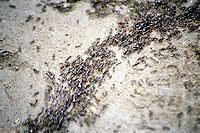
Photo from wikipedia
Highlights In this paper, an improved ant colony algorithm is proposed for optimizing the sensor placement path. The experimental data derived from field measurements. The method in this paper reduces… Click to show full abstract
Highlights In this paper, an improved ant colony algorithm is proposed for optimizing the sensor placement path. The experimental data derived from field measurements. The method in this paper reduces the number of sensors and the investment cost. The test results show that data redundancy, data transmission distance, and network energy consumption are reduced. Abstract. In the optimized layout of tea plantation sensors, the number and location of sensors, energy consumption of sensors, and data redundancy are all important factors that affect the layout. To reduce data redundancy, network energy loss, and the cost of sensors, an improved ant colony is proposed. The algorithm optimizes the sensor layout of the tea plantation. Introduce data redundancy and network energy consumption models into the heuristic function to guide the ants to choose the path with less data redundancy and less energy loss; add the path trend guide G to the probability transfer formula to guide the ants from the source node to the sink node Search the path, reduce the path length and the number of sensors. A tea plantation in the National High-tech Agricultural Park of Anhui Agricultural University was selected as the test area, and 25 sensor nodes were randomly arranged to collect soil moisture data for the experiment. The improved ant colony algorithm optimized the path data with less redundancy, less network energy consumption and short distance. Only 6 sensors are needed, reducing the sensor from the initial 25 to 6, which reduces the cost. In order to eliminate the accidental problem of the research results, the soil moisture data collected on August 29, 2019 was selected for the verification test, and the test results were good.
Journal Title: Applied Engineering in Agriculture
Year Published: 2021
Link to full text (if available)
Share on Social Media: Sign Up to like & get
recommendations!